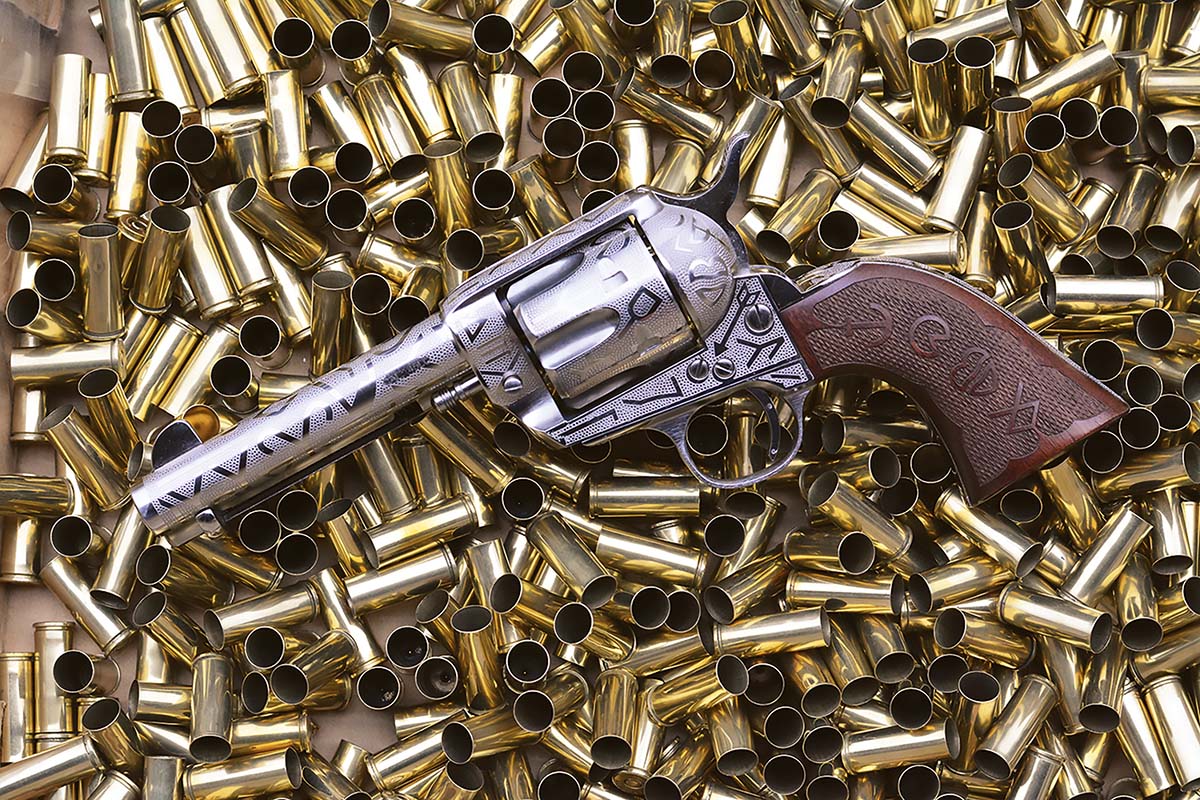
The Pietta Great Western II SAA pattern sixgun is offered in a variety of calibers and finishes. This Cattlebrand gun features laser engraved brands and nickel plating.
Giuseppe Pietta started producing replica firearms between 1962 and 1964. However, his company’s most successful and best-known gun is the Single Action Army (SAA) pattern revolver. Beginning in 2003, Early Modern Firearms (EMF) worked with Italian-based Pietta to produce an SAA sixgun that would replicate the original Colt but with some minor changes. EMF began importing this gun as the Great Western II, which has been a huge success, but there is much more to this story.
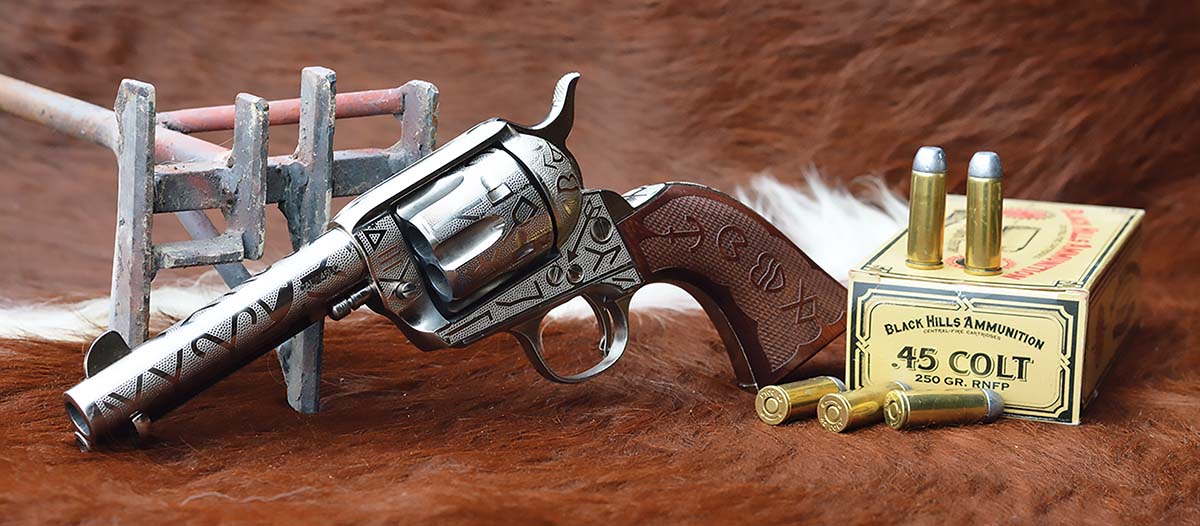
Cattle brands are associated with the Old West and have been popular with gun engravers.
The original Great Western Arms Company was founded in 1953 and by 1954 was producing Colt SAA pattern guns (as well as copies of the Remington derringer, cap-n-ball sixguns, etc.) that were 100 percent made in California, USA. Demand was high, and they sold every gun they could produce. Hollywood often used Great Western Frontiers revolvers in movies and TV series, and even John Wayne became a company spokesman. Wayne even used a consecutive pair of fully engraved Great Western sixguns in his 1976 movie
The Shootist, his last and considered his best by many. Great Western Arms was founded prior to Colt reintroducing their second-generation series SAA in 1955. When Colt began offering the original, this spelled trouble for the young company. While they initially struggled with quality problems, they eventually produced a quality gun. However, financial struggles resulted in their demise in 1964, with the last guns sold as do-it-yourself kits. EMF advertised Great Western guns for sale as early as 1956; however, by 1959, they had purchased the company.
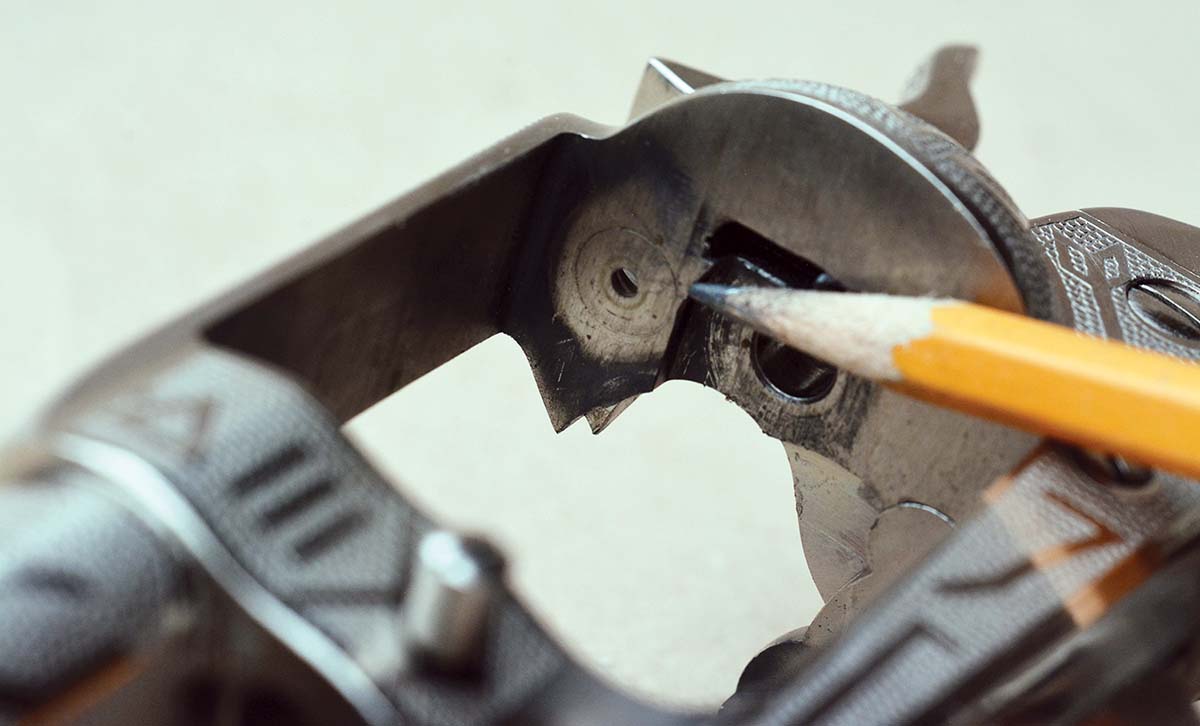
The Pietta Great Western II features a replaceable recoil plate, the same as the Colt SAA.
As indicated during the early 2000s, EMF owner and founder Boyd Davis worked with Pietta to produce the Great Western II single action that has several important features that make it a standout clone. First, it features more or less the same size of frame and cylinder as the original Colt. More specifically, the outside cylinder diameter is between 1.650 and 1.655 inches (measured on several guns), while the original Colt measures 1.650 inches. The cylinder length measures 1.613 to 1.615 inches (again checked on several guns) and is essentially identical to Colt SAAs. (Note: most other clones, including Uberti, USFA and Standard Manufacturing, all feature larger diameter cylinders.) It features the Colt-style removable cylinder bushing that allows easy end shake correction after being fired in volume. The barrel features an ejector tube stud, which along with the ejector tube screw, offers support to the ejector housing during recoil. This should be of special interest to those that shoot in high volume. It should be noted that this is the same design that was put on Colt SAAs since the 1870s.
Another important feature is a hardened recoil plate, which has been a feature on all Colt SAA Model 1873s since 1872. This plate prevents damage to the frame and is easily replaced in the event that the firing pinhole becomes worn or egg-shaped. (Note: Early Piettas did not have the recoil plate.)
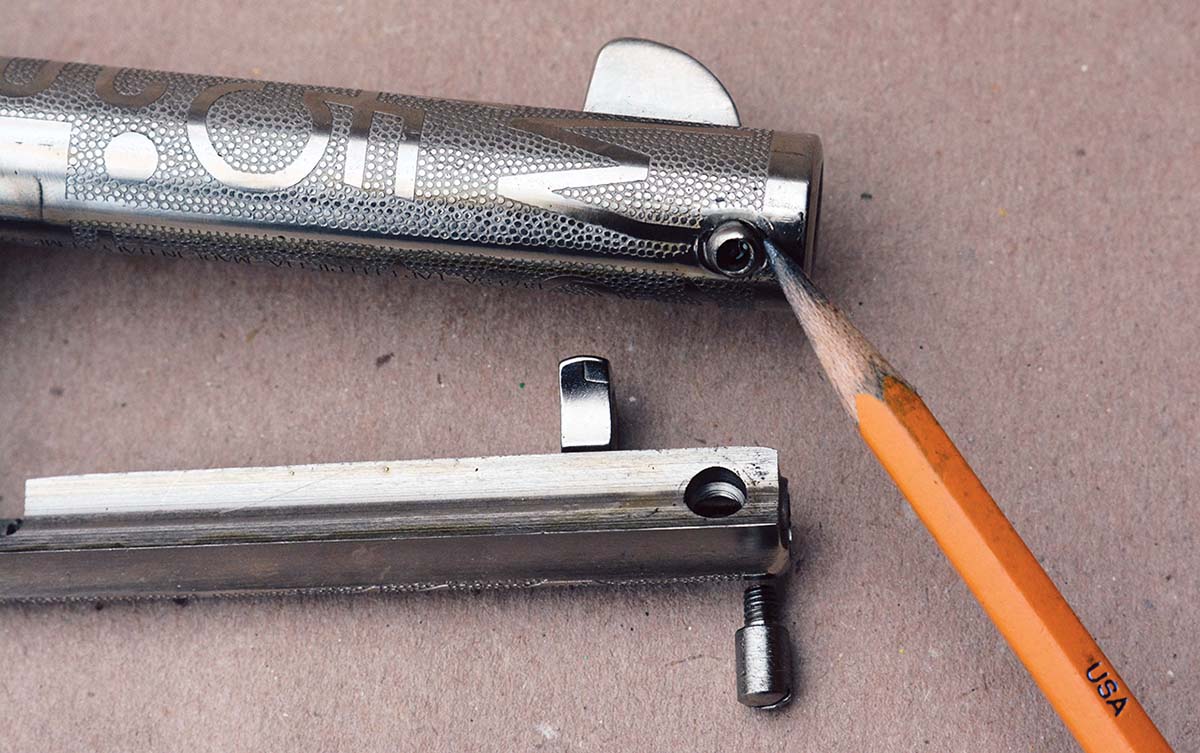
The Pietta Great Western II features an ejector tube stud that helps keep the ejector housing from coming loose.
The hammer is patterned after the original Colt, without any internal safety. This is a really good thing, as the hammer is the driving mechanism, the engine if you will, in a single-action sixgun. Hammers that have safety mechanisms usually have smaller cams that ultimately wear out prematurely, increase wear to the bolt, modify the timing, etc. The original Colt hammer design needs no improvement. Incidentally, the hammer features the standard three positions, with the first notch being the so-called safety notch, the half-cock position for loading and unloading, and the full-cock that is ready to fire. The hammer-mounted firing pin floats, similar to current Colt SAAs.
The Pietta safety includes the base pin that has two notches for the base pin screw, nut and spring to engage (aka cross-pin). When the base pin screw is engaged in the upper notch, the base pin protrudes out the rear of the frame around .200-inch, preventing the hammer and firing pin from reaching the primer of a cartridge. This is known as the Swiss Safety and allows the gun to pass import safety requirements, but it is completely impractical to be carried in this position. When the base pin is engaged, with the base pin screw engaging the lower notch, the gun will fire and function normally. Incidentally, the base pin is .250 inch in diameter, so it will readily accept a genuine Colt base pin if this feature is bothersome.

The Great Western II base pin (bottom) features two slots for the base pin screw (aka cross-pin) that serves as the Swiss Safety to pass import tests. The Colt base pin (top) can be used in the Pietta sixguns.
It should be noted that the hammer’s first cock notch or safety position, should not be relied on for safety. If the gun is dropped or the hammer spur is bumped, the trigger sear can break off, and the gun will fire. Rather, it is a much safer method only to carry 5 cartridges and lower the hammer on the empty chamber. Personally, I don’t like to engage the first cock notch even if the gun has an empty chamber, as this runs the risk of unnecessarily breaking the trigger sear. To load 5 cartridges, place a round in a chamber, then leave the next chamber empty and then load 4 rounds. After the 4th cartridge is loaded, bring the gun to the full-cock position and then lower the hammer on the empty chamber. Additionally, this method prevents the bolt from dragging on the cylinder that leaves a “drag ring.” The empty chamber can be viewed from the side to confirm that the gun is safe to holster and cannot fire if dropped, hit, etc. Properly handled, the single action is ultra-safe!
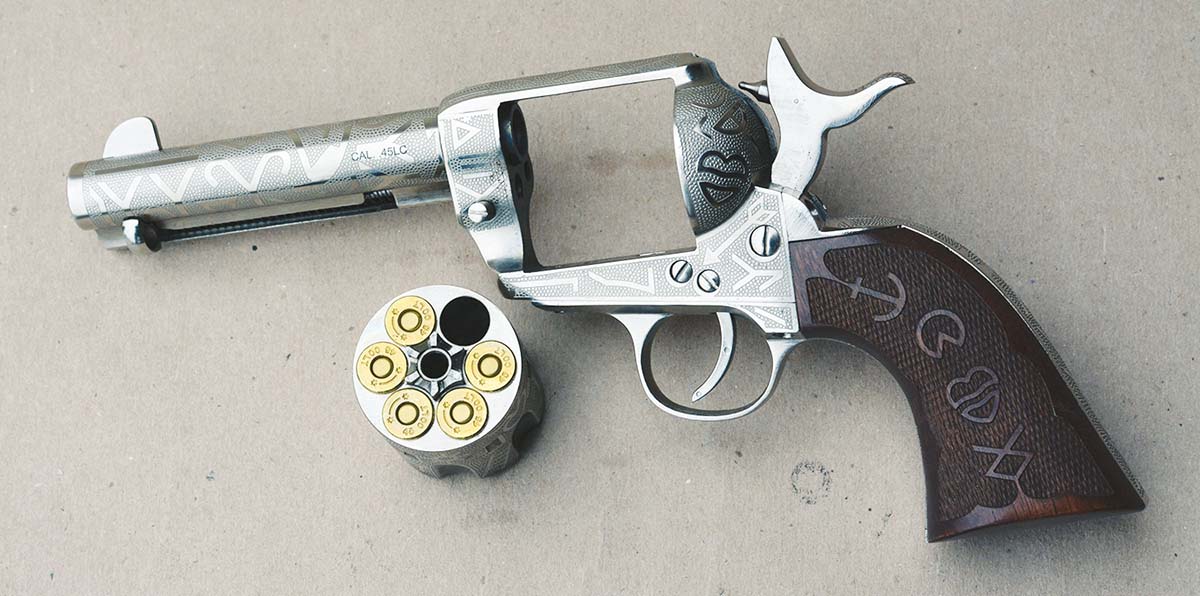
Being a Colt SAA pattern sixgun, it is best to carry loaded with just 5 cartridges with the hammer resting on the empty chamber.
In 2014, EMF founder Boyd Davis passed away, and Pietta purchased EMF; however, long-time employee Debbie Sims has become the president and CEO. Operations remain the same, and she has expanded the Great Western II product line. It should be noted that other companies import Pietta, including Cimarron, Cabela’s and several others. Calibers include 9mm Luger, 38 Super, 357 Magnum, 44-40 Winchester, 45 ACP, 45 Colt and many come as convertible options. The finish configurations are extensive and include blue with case coloring, nickel and silver plating, brass back strap and trigger guard, various engraving patterns and stock options.
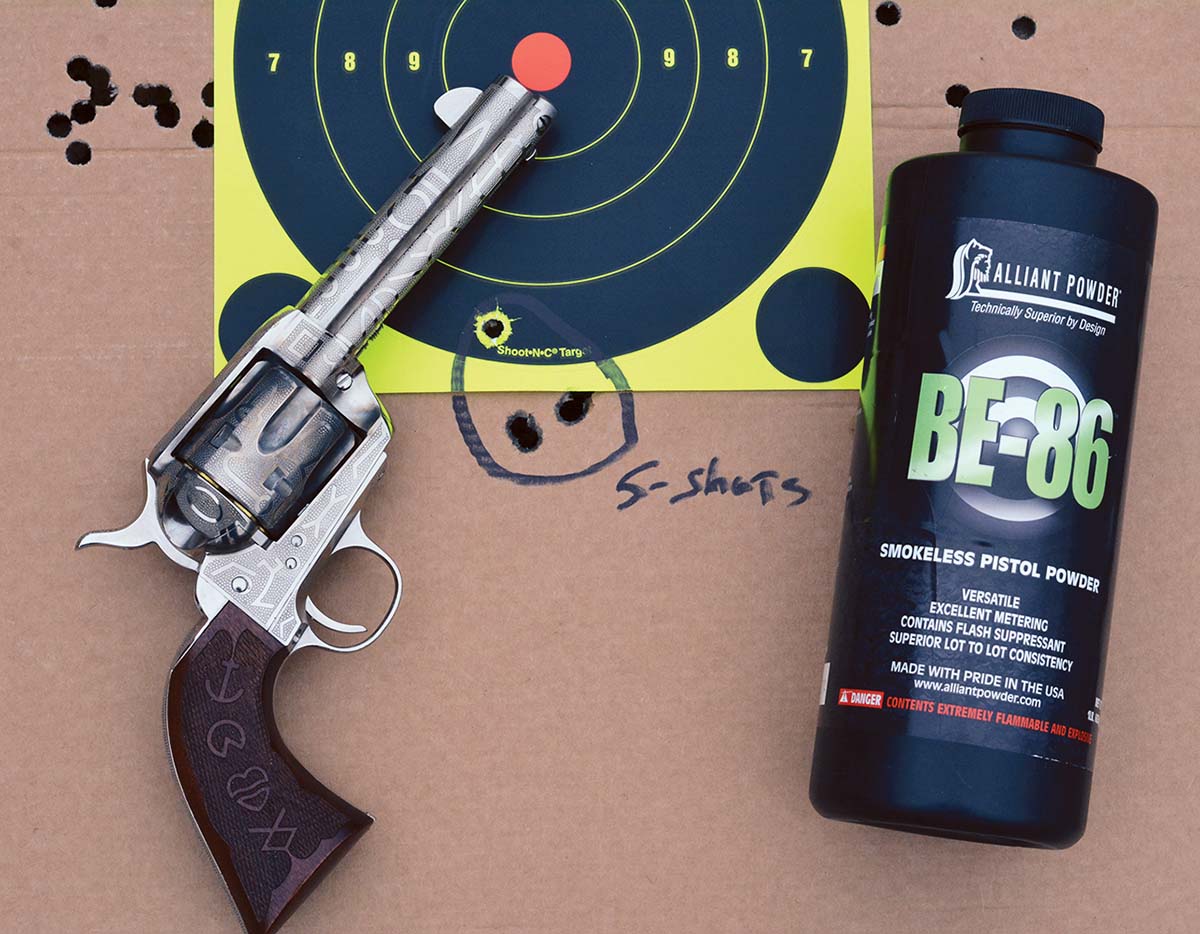
Accuracy at 25-yards was good. However, all loads grouped well below the point of aim. Shortening the front sight will allow the gun to be sighted in for a given shooter and load.
While I favor a blue finish with case coloring, I was forwarded an interesting Great Western II Cattlebrand chambered in 45 Colt, 43⁄4-inch barrel and nickel plated. The gun features full-coverage laser-engraved cattle brands with a dotted background. Cattle brands are often associated with the Old West; however, they are still used extensively today to identify cattle ownership and help prevent rustling. Yes, cattle rustling still occurs today, as this rancher had more than $30,000 worth of cattle stolen in recent years! State laws vary, but basically, a person or a ranch will register a brand that is placed by hot iron on a specific part of a cow’s body such as right ribs, left shoulder, right hip, etc. In open range areas, or when cattle get out and end up on property where they don’t belong, it is easy for the state brand inspector or other ranchers to identify the owner. These brands are also intended to be difficult to for rustlers to “touch up” with a running iron and changed to a different brand. If a rustler gets caught selling cattle with someone else’s brand, it will not go well for them. Cattle brands are very much a part of the old and new West alike!
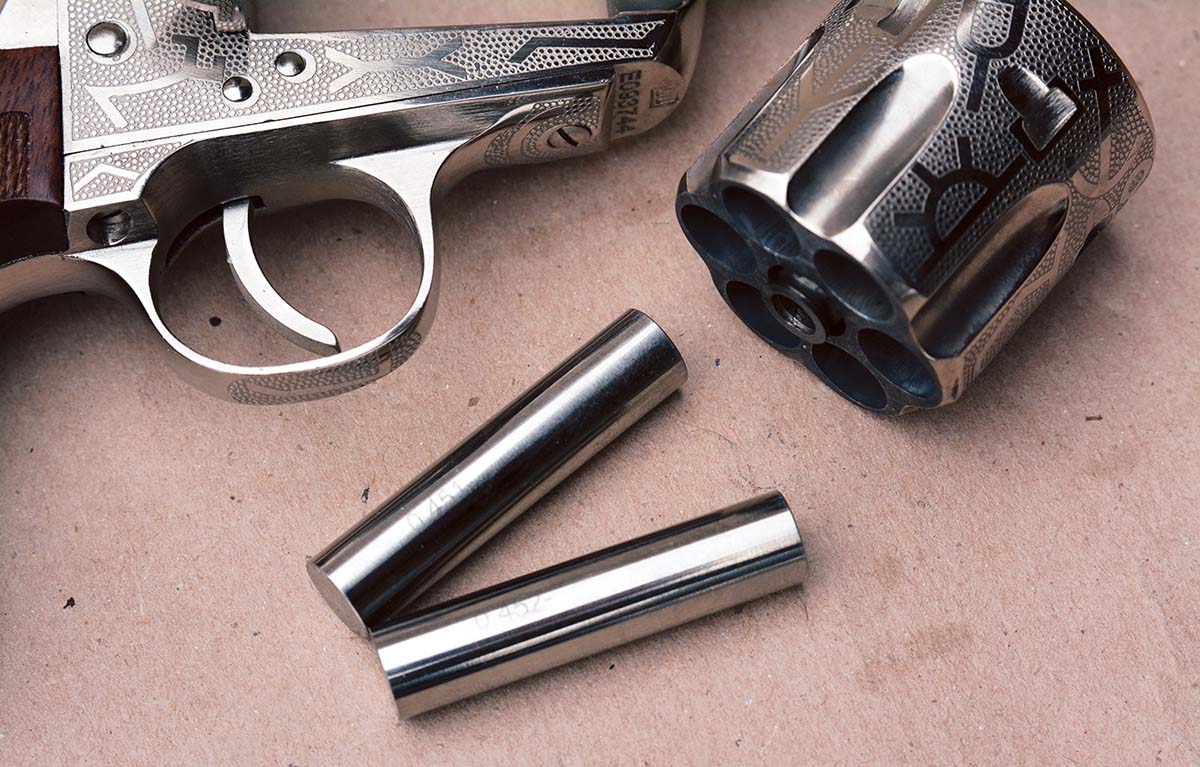
Precision ground plug gauges were used to measure chamber throats at .4515 inch.
I doubt anyone really knows who first began applying cattle brands to Colt SAAs. However, one early example was produced by Mexican engraver Sergio Moreno of San Antonio, Texas, around 1885. The gun was given to Judge Roy Bean by famous British stage actress, Lily Langtry and was fully engraved with famous Texas brands along with small scroll patterns entwined. However, master engraver Cole Agee (1901-1955) is often credited for popularizing cattle brands. Several modern engravers have carried on that tradition. However, master pattern, hand-engraved guns can be comparatively costly to execute. The laser engraving on the Pietta Great Western II only adds modestly to the cost of a gun that is already a bargain.
Right out of the box, the sample Great Western II sixgun is timed properly with the bolt dropping in the approaches and the cylinder locking up tight. Side play and end shake are both minimal. The hammer full-cock notch and trigger sear relationship engage perfectly, and the chambers center in the loading trough. The action is smooth and light, and the trigger pull breaks at 4 pounds. The barrel cylinder gap is .007 inch. Incidentally, the barrel is cold-hammer forged, and the forcing cone is cut at what appears to be 11 degrees. The cylinder is machined from European steel, which is the equivalent of U.S. 4130 chrome-moly. The chamber throats measure .4515 inch, and each chamber ranges ideally, which is conducive to good accuracy. Internally, the gun functions identically to the Colt SAA; however, the hand is powered by a coil spring rather than the leaf spring found on Colts. Overall, fit and finish are good.

The Great Western II features the same size cylinder as the Colt SAA at around 1.650 inches.
As can be seen in the accompanying tables, both factory loads and handloads gave respectable accuracy, with three, five-shot 25-yard groups usually hovering from 1.50 to 2.25 inches. The most accurate factory load was the old Remington 250-grain lead roundnose that has been reduced from the long-standing stated velocity of 860 feet per second (fps) to 750 fps. Groups averaged 1.80 inches. The most accurate handload consisted of 263-grain bullets cast from RCBS mould 45-250-FN pushed to 865 fps using 7.0 grains of Accurate No. 2 powder that averaged 1.45 inches.
It should be noted that all loads grouped low at 25 yards. The front sight is fairly tall and can be carefully lowered to bring the point of impact to center for a given load and shooter.
The Pietta Great Western II is an outstanding Colt clone that offers accuracy, reliability and quality, and is available in many finishes. Base guns have a starting MSRP price of around $450, while the Cattlebrand gun sells for around $850.









.jpg)
.jpg)
.jpg)


